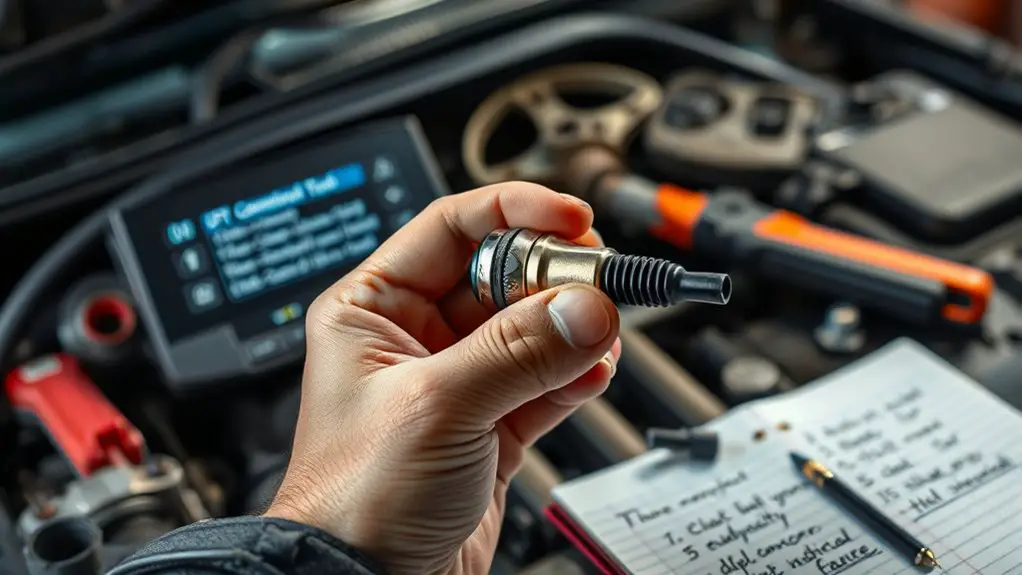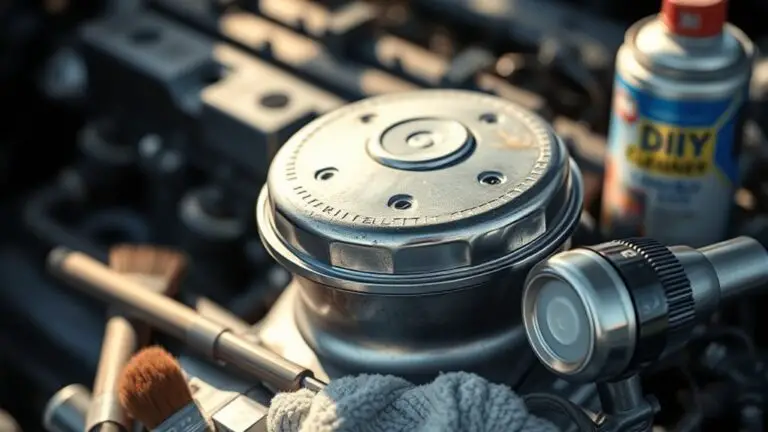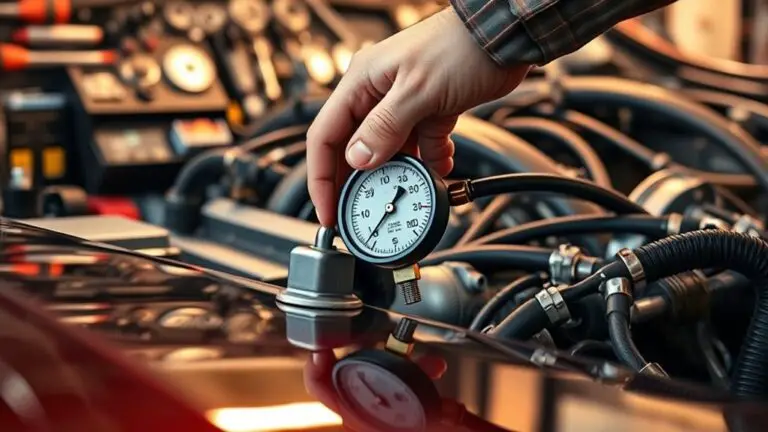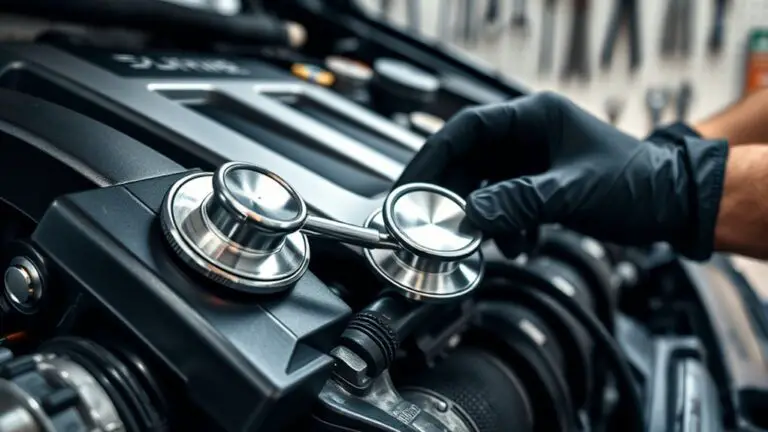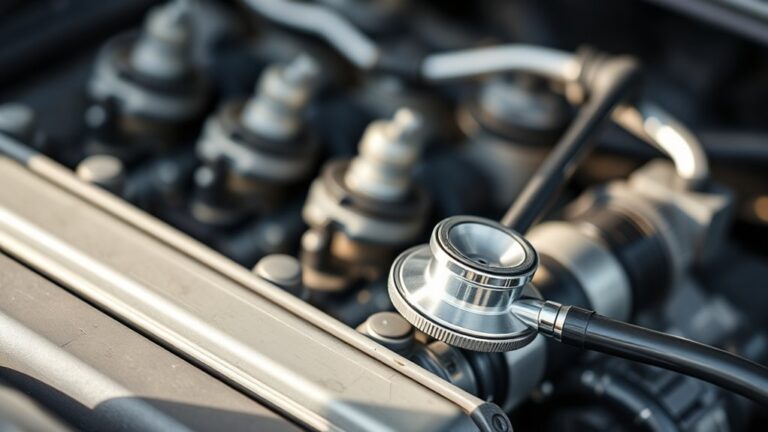When to Replace the Camshaft Position Sensor: Signs, Procedure and Cost
If you’re experiencing engine stalling, poor acceleration, or a check engine light, it might be time to replace your camshaft position sensor. Diagnosing issues involves using tools like an OBD-II scanner and multimeter. Replacement requires disconnecting the battery and using proper tools for installation. Costs typically range from $100 to $400, including parts and labor. For details on the replacement procedure and tips for sensor longevity, you’ll find more helpful insights ahead.
Understanding the Camshaft Position Sensor
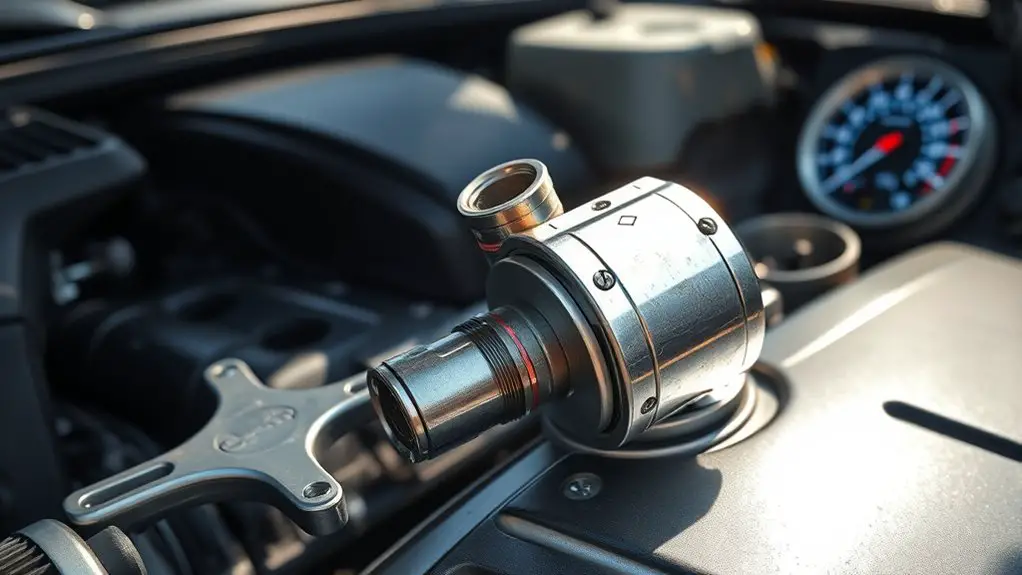
The camshaft position sensor (CMP sensor) plays an essential role in your vehicle’s engine management system. It monitors the position of the camshaft, enabling the engine control unit (ECU) to optimize fuel injection and ignition timing. This precise sensor functionality guarantees your engine operates efficiently and smoothly.
When installing a CMP sensor, it’s vital to follow certain installation tips. First, disconnect the battery to prevent electrical shorts. Make certain to clean the mounting area before installation to guarantee a proper seal. Align the sensor correctly to avoid misreading, which could lead to engine performance issues. After installation, reconnect the battery and check for any diagnostic trouble codes using an OBD-II scanner to confirm proper functionality. Understanding these aspects can empower you to maintain your vehicle’s performance and guarantee a responsive driving experience.
Common Symptoms of a Failing Camshaft Position Sensor
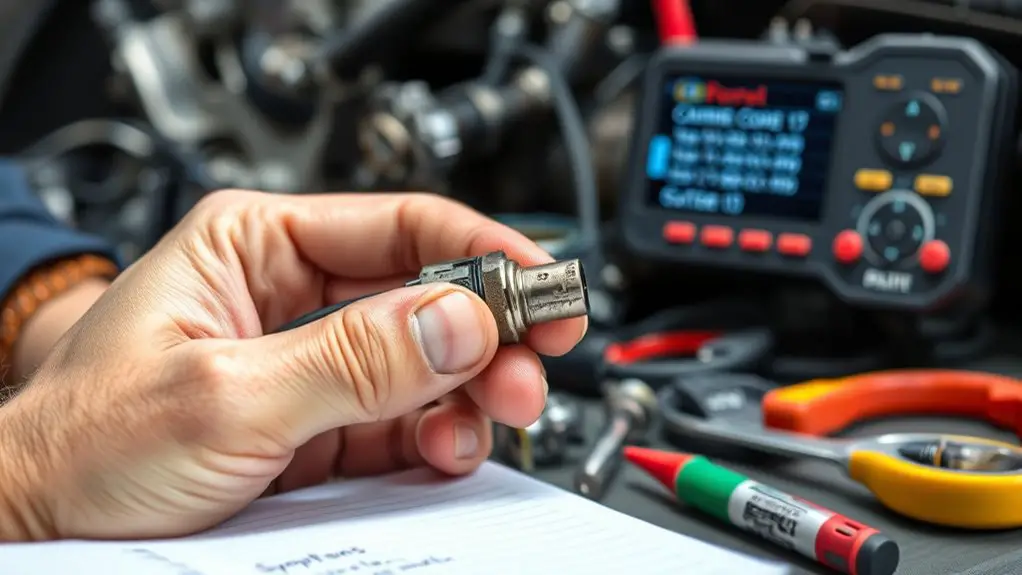
If your camshaft position sensor is failing, you might notice several engine performance issues, such as rough idling or stalling. Additionally, the check engine light may illuminate, signaling that there’s a problem. Starting difficulties can also arise, making it essential to recognize these symptoms early on.
Engine Performance Issues
When your vehicle experiences engine performance issues, it might be a sign that the camshaft position sensor is failing. This sensor plays an important role in your engine’s timing and efficiency. You may notice:
- Engine stalling during acceleration
- Performance lag when trying to increase speed
- Unusual engine noises or vibrations
- Decreased fuel efficiency
These symptoms can greatly impact your driving experience, making your vehicle less responsive and reliable. If you’re facing any of these issues, it’s vital to diagnose the problem promptly. Ignoring these signs could lead to more severe engine problems and costly repairs down the line. Taking action now can restore your vehicle’s performance and guarantee a smoother ride.
Check Engine Light
How can a failing camshaft position sensor affect your vehicle’s diagnostics? When this sensor malfunctions, it can trigger your check engine light, serving as an important warning sign. The camshaft position sensor plays a critical role in ensuring your engine runs smoothly by providing crucial information to the engine control unit (ECU). If it fails, the ECU may receive incorrect data, leading to poor engine performance, increased emissions, and potential engine stalling. Besides the check engine light, you might notice other warning signs like erratic idling or reduced power. It’s important to address these issues promptly to avoid further damage. Ignoring these symptoms can lead to costly repairs down the line. Stay vigilant and act on these warning signs.
Starting Difficulties
Starting difficulties often signal a failing camshaft position sensor, as this component is essential for proper engine timing. If you experience starting issues, it could be due to incorrect timing signals being sent to the engine control unit, leading to problems during engine cranking.
Look out for these common symptoms:
- Engine cranks but doesn’t start
- Rough idling or stalling after starting
- Delayed engine response when you attempt to start
- Check engine light illuminated
Addressing these signs early can save you from more severe engine damage down the line. If you suspect the camshaft position sensor is the culprit, consider getting it assessed and replaced to restore your vehicle’s performance and reliability.
Diagnosing Camshaft Position Sensor Issues
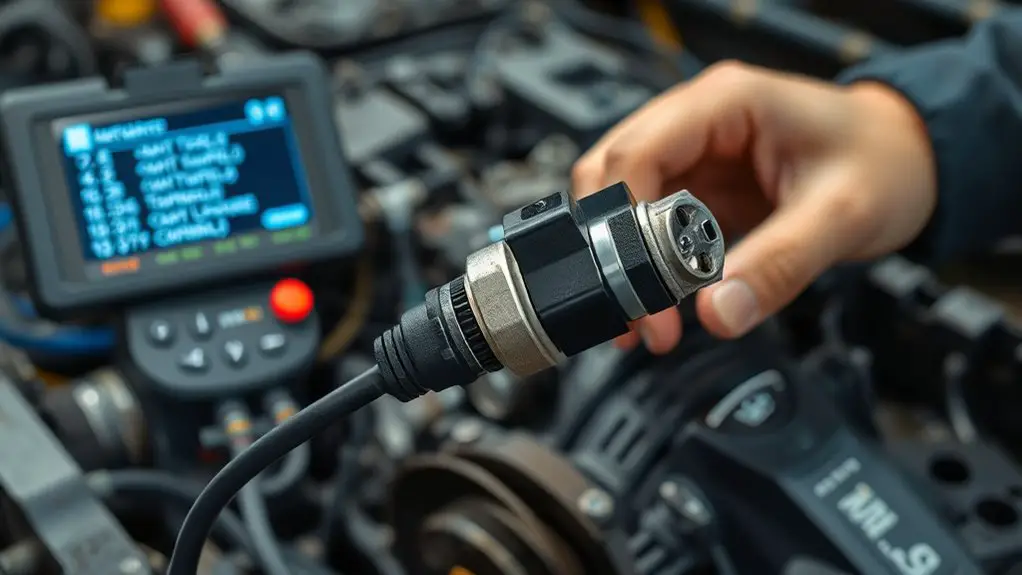
To effectively diagnose camshaft position sensor issues, you first need to recognize the common symptoms associated with a failing sensor, such as engine misfires or poor acceleration. Once you’ve identified these symptoms, you can proceed with diagnostic testing methods to confirm the root cause. Accurate diagnosis is essential for ensuring proper vehicle performance and preventing further engine damage.
Common Symptoms Identified
Identifying issues with the camshaft position sensor (CPS) is essential for maintaining ideal engine performance. Different sensor types can exhibit various symptoms, so being aware of these signs can help you determine replacement frequency. Here are some common symptoms of a failing CPS:
- Engine misfires or stalling: Inconsistent signals can disrupt timing.
- Decreased fuel efficiency: An incorrect position can lead to poor fuel management.
- Check Engine Light: A warning light may indicate CPS malfunctions.
- Rough idling: Erratic engine behavior often points to sensor issues.
Diagnostic Testing Methods
Once you’ve recognized the symptoms of a failing camshaft position sensor, it’s important to conduct diagnostic testing to pinpoint the exact issue. Utilize diagnostic tools like a multimeter or an oscilloscope for effective sensor testing. These devices help you measure voltage and signal output, ensuring the sensor operates within specifications.
| Diagnostic Tool | Purpose |
|---|---|
| Multimeter | Measure voltage levels |
| Oscilloscope | Analyze signal waveform |
| OBD-II Scanner | Read error codes |
How to Replace the Camshaft Position Sensor
Replacing the camshaft position sensor is a straightforward process that can often be completed in under an hour with the right tools and knowledge. You’ll need to identify the correct sensor type for your vehicle, as replacement frequency can vary depending on the make and model.
Here’s a step-by-step guide to help you through the replacement:
- Disconnect the battery: Safety first! Prevent any electrical issues.
- Locate the sensor: It’s usually near the camshaft. Refer to your vehicle’s manual for specifics.
- Unplug the connector: Carefully detach the electrical connector from the sensor.
- Remove and replace: Unscrew the old sensor, install the new one, and reconnect everything.
Always double-check your work to verify everything is secure. Remember, regular checks on your camshaft position sensor can prevent future issues, enhancing your vehicle’s performance and longevity.
Tools Required for Replacement
Before you start the replacement process, it’s vital to gather the right tools to guarantee a smooth and efficient job. You’ll need a set of socket wrenches, including various sizes to fit the bolts securing the sensor. A torque wrench is also essential for ensuring the correct tightness when reinstalling. Don’t forget a flathead and Phillips screwdriver for any clips or covers you might encounter during the removal.
For sensor testing, a multimeter can help you check the old sensor’s functionality before you proceed with the new installation. Additionally, having an OBD-II scanner will allow you to read any trouble codes related to the camshaft position sensor, streamlining your troubleshooting process. Finally, consider having a clean rag and some engine oil handy to lubricate the new sensor’s O-ring. With these replacement tools at your side, you’ll be well-prepared to tackle the job efficiently.
Step-by-Step Replacement Procedure
With the necessary tools gathered, you’re ready to begin the replacement of the camshaft position sensor. Start by disconnecting the battery to guarantee safety. Next, locate the sensor; it’s typically near the camshaft cover. Depending on the sensor types, you might need to remove surrounding components for better access. Follow these installation tips for a smooth process:
- Clean the mounting surface to prevent leaks.
- Align the new sensor properly before securing it.
- Use a torque wrench to tighten bolts to manufacturer specifications.
- Reconnect the electrical connector securely.
Once installed, reconnect the battery and start your vehicle. Check for any warning lights on the dashboard and verify the engine runs smoothly. If any issues persist, double-check your connections. You’ve now successfully replaced the camshaft position sensor!
Cost of Replacing the Camshaft Position Sensor
The cost of replacing a camshaft position sensor typically ranges between $100 and $400, depending on your vehicle’s make and model. Sensor pricing can vary considerably based on factors such as brand and compatibility. It’s essential to account for installation costs, which can add another $50 to $150 to the total expense if you’re having a professional do the work.
Here’s a quick breakdown for reference:
| Vehicle Type | Sensor Pricing | Installation Costs |
|---|---|---|
| Economy Cars | $100 – $200 | $50 – $100 |
| Mid-range Vehicles | $150 – $300 | $100 – $150 |
| Luxury/Performance Cars | $250 – $400 | $100 – $150 |
Keep these factors in mind to budget effectively for your camshaft position sensor replacement.
Maintenance Tips for Longevity of the Sensor
To guarantee the longevity of your camshaft position sensor, regular maintenance of your vehicle’s engine is essential. Prioritizing sensor care will help you avoid costly repairs down the line. Here are some maintenance tips to make certain your sensor stays in prime condition:
Regular engine maintenance is key to ensuring your camshaft position sensor remains functional and avoids costly repairs.
- Conduct regular inspections: Frequently check the sensor and surrounding wiring for damage or wear.
- Keep the engine clean: A clean engine reduces the risk of debris affecting the sensor’s performance.
- Monitor engine fluid levels: Make sure oil and coolant levels are adequate to prevent overheating and sensor failure.
- Address warning lights promptly: If the check engine light appears, get a diagnostic to prevent further damage.
Frequently Asked Questions
Can a Faulty Camshaft Position Sensor Damage the Engine?
Yes, a faulty camshaft position sensor can indeed damage your engine. If the sensor’s not providing accurate readings, it can lead to poor engine performance, causing misfires or even stalling. Over time, this can strain other components, resulting in costly repairs. Regular sensor diagnostics are essential to maintain peak performance and prevent further issues. Don’t overlook this small but important part; it plays a significant role in your engine’s health and efficiency.
Is It Safe to Drive With a Failing Camshaft Position Sensor?
It’s not safe to drive with a failing camshaft position sensor. You might experience sensor symptoms like poor engine performance, stalling, or difficulty starting. These issues can lead to driving risks, including reduced acceleration and unexpected engine shutdowns. Ignoring these signs could result in more severe engine damage and higher repair costs down the line. To maintain your vehicle’s reliability, it’s best to address the problem promptly.
How Often Should I Inspect the Camshaft Position Sensor?
You should inspect the camshaft position sensor every 30,000 to 50,000 miles, or during routine maintenance checks. Regular inspection frequency helps catch potential issues early, ensuring peak engine performance. Sensor maintenance tips include checking for loose connections, signs of wear, or oil leaks around the sensor. Keeping an eye on these aspects can prevent larger problems down the road, allowing you to enjoy driving without unnecessary interruptions or repairs.
Are There Aftermarket Camshaft Position Sensors Available?
Yes, there are aftermarket camshaft position sensors available, offering various options for your vehicle. When selecting one, verify sensor compatibility with your specific make and model to avoid issues. Aftermarket sensors can often provide similar performance to OEM parts at a lower price. However, it’s essential to research the brand and read reviews to guarantee reliability. With the right choice, you can maintain your engine’s performance while enjoying cost savings.
What Is the Warranty Typically Offered on Replacement Sensors?
Typically, aftermarket camshaft position sensors come with a warranty coverage ranging from one to three years, depending on the brand and quality. While a sensor’s lifespan can vary, it’s vital to take into account the warranty as a safety net. You want to guarantee you’re protected against premature failure, allowing you the freedom to drive without worry. Always check the specifics of the warranty to make an informed decision when purchasing a replacement.

